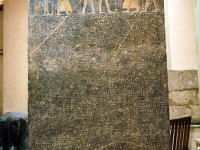Today we move into the Book of Alma.
The stories of Alma Sr. and Alma Jr. are a major focus of the Book of Mormon; If we start in Mosiah 17, where Alma first appears, and count through the end of the Book of Alma, it’s roughly 40% of the entire Book of Mormon, by wordcount. (I generated this using Bibleworks 10, though it is off by a bit, because my electronic text doesn’t include original chapter or book headings. Total Book of Mormon count is roughly 267,000 and Mosiah 17-Alma is roughly 99,400.)
Why did Mormon choose to spend so much time on the period of the Almas, and so little on, say, 4th Nephi? Is it source dependant? (Mormon can’t write what he doesn’t have sources for.) Is it something about the material that Mormon found particularly useful or relevant?
Continue reading

 These chapters are the violent dénoument of the Ammonihah story. Grant Hardy cogently points out how this story with Alma/Amulek parallels an earlier story with Abinadi.
These chapters are the violent dénoument of the Ammonihah story. Grant Hardy cogently points out how this story with Alma/Amulek parallels an earlier story with Abinadi. 







Recent Comments